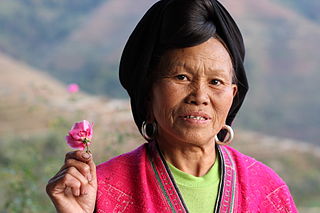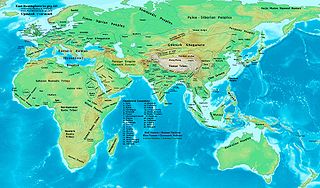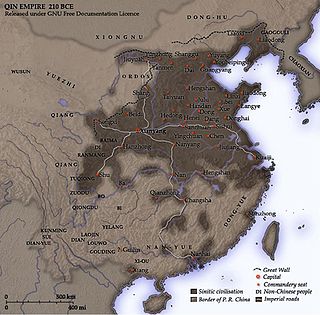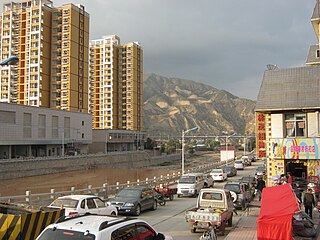
Qinghai is a landlocked province in Northwestern China. As one of the largest province-level administrative divisions of China by area, the province is ranked fourth-largest in area and has the third-smallest population. Its capital and largest city is Xining.
The Bonan people are an ethnic group living in Gansu and Qinghai provinces in Northwestern China. They are one of the "titular nationalities" of Gansu's Jishishan Bonan, Dongxiang and Salar Autonomous County, which is located south of the Yellow River, near Gansu's border with Qinghai.

Qingpu District, is a suburban district of Shanghai Municipality. Lake Dianshan is located in Qingpu.

The Yao people is a government classification for various minorities in China and Vietnam. They are one of the 55 officially recognised ethnic minorities in China and reside in the mountainous terrain of the southwest and south. They also form one of the 54 ethnic groups officially recognised by Vietnam. In the last census in 2000, they numbered 2,637,421 in China and roughly 470,000 in Vietnam.

Tuyuhun was a powerful kingdom established by nomadic peoples related to the Xianbei in the Qilian Mountains and upper Yellow River valley.

Murong (Chinese: 慕容; pinyin: Mùróng; Wade–Giles: Mu4-jung2) or Muren refers to an ethnic Xianbei tribe who are a Mongolic people attested from the time of Tanshihuai (reigned 156-181). Different strands of evidence exist linking the Murong to the Mongols. Murong is also a Chinese surname. The Former Yan (337-370), Western Yan (384-394), Later Yan (384-409) dynasties as well as Tuyuhun (285-670) were all founded by the Murong peoples.

Donghu was a tribal confederation of nomadic people that was first recorded from the 7th century BCE and was destroyed by the Xiongnu in 150 BCE. They lived in northern Hebei, southeastern Inner Mongolia and the western part of Liaoning, Jilin and Heilongjiang along the Yan Mountains and Greater Khingan Range.
The Hlai languages are a primary branch of the Kra–Dai language family spoken in the mountains of central and south-central Hainan in China, not to be confused with the colloquial name for the Leizhou branch of Min Chinese. They include Cun, whose speakers are ethnically distinct. A quarter of Hlai speakers are monolingual. None of the Hlai languages had a writing system until the 1950s, when the Latin script was adopted for Ha.

The Xianbei state or Xianbei confederation was a nomadic empire which existed in modern-day Mongolia, Inner Mongolia, northern Xinjiang, Northeast China, Gansu, Buryatia, Zabaykalsky Krai, Irkutsk Oblast, Tuva, Altai Republic and eastern Kazakhstan from 156-234. Like most ancient peoples known through Chinese historiography, the ethnic makeup of the Xianbei is unclear.

Minhe Hui and Tu Autonomous County is the easternmost county in Qinghai Province, China. It is under the administration of Haidong Region. "Hui" refers to the Chinese Muslims, whereas "Tu" refers to the ethnic group known as “Monguor” in the West and as "Tu Zu" in China. It borders the Honggu District of Gansu on the east, demarcated by the Datong River, a tributary to the Huangshui River, which eventually flows into the Yellow River.

Guanting is a town in eastern Qinghai province, People's Republic of China. It is located in the southeast of Minhe County and, together with Guanting, Zhongchuan, Xiakou, Gangou and Xin'er townships, is referred to as the Guanting Area (官亭地区).
Qinghai University for Nationalities is a university in Xining, Qinghai, China. It was established in December 1949 and was Qinghai's earliest university of higher education.
Junast was a Chinese linguist of Mongolian ethnicity who specialized in the study of the Monguor language, Eastern Yugur language and the 'Phags-pa script.
The Xong language, is the northern-most Hmongic language, spoken in south-central China by ca 0.9 million people. It's called Xiangxi Miaoyu (湘西苗语), Western Hunan Miao, in Chinese. In Western sources, it's been called Eastern Miao, Meo, Red Miao and North Hmongic. The official alphabet was adopted in 1956.
Caijia is an endangered Sino-Tibetan language spoken in an area centred on Bijie, in the west of the Chinese province of Guizhou. It was discovered in the 2000s. It has been described by different authors as a relative of Bai or an early branching from Old Chinese. The autonym is.
Zhuang Xueben was one of China's first ethnographic photographers. In the 1930s, he left his native Shanghai and travelled to western China to photograph the minority people in four provinces: Sichuan, Yunnan, Gansu, and Qinghai. During the almost ten years of ethnographic research, he took more than ten thousand photographs and wrote a vast amount of materials including research reports, travel notes, and journals. In 1941, he held a photographic exhibition on Xikang in several Chinese cities and about 200,000 people attended the exhibit. These photos and written materials have become a valuable source for anthropologists to the ethnic groups in western China.














